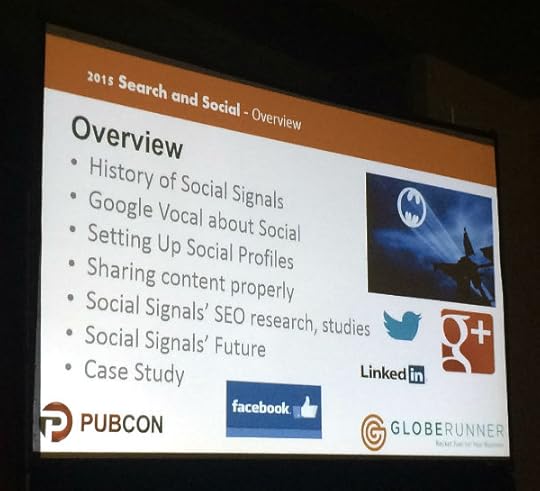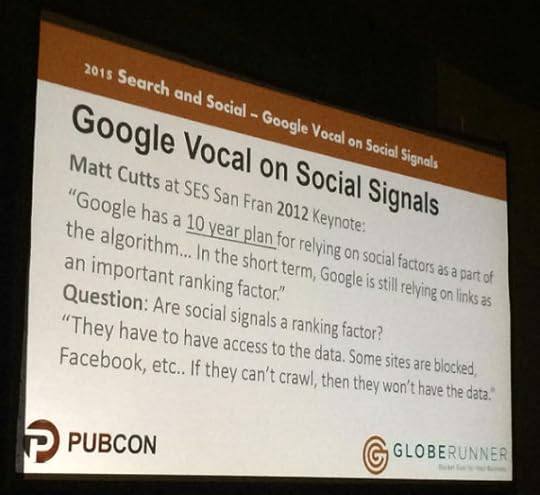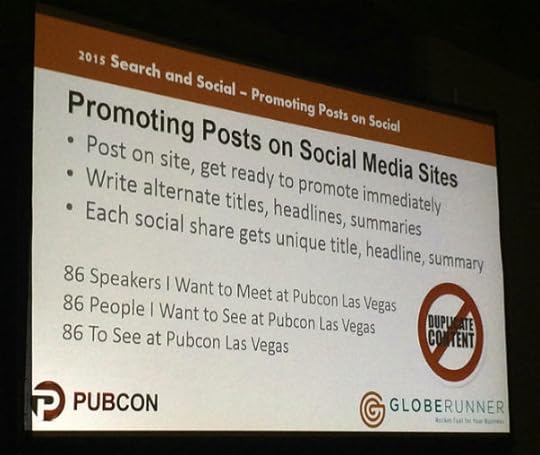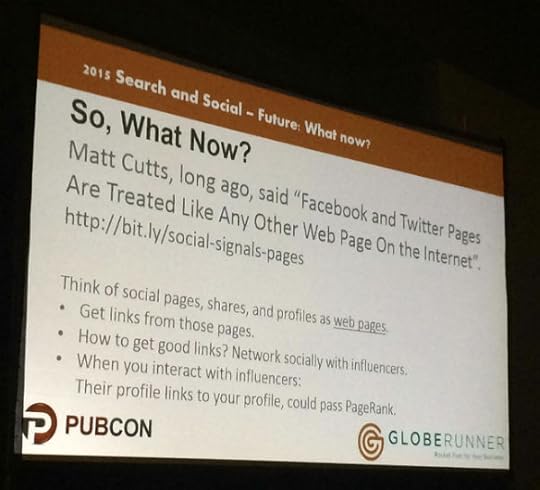Bruce Clay's Blog, page 22
October 8, 2015
The Future of Search: Duane Forrester’s Keynote at Pubcon (Liveblog)
The Future of Search: Duane Forrester’s Keynote at Pubcon (Liveblog) was originally published on BruceClay.com, home of expert search engine optimization tips.
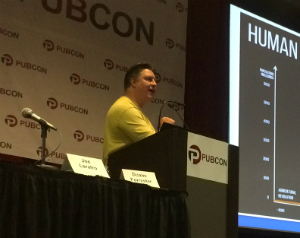 Bing’s face of search, Duane Forrester (@DuaneForrester), is going to deliver a lively keynote at Pubcon Las Vegas 2015. Titled “The Future of Search May Not Be What You Expect, his stat-packed talk will cover many topics, including:
Bing’s face of search, Duane Forrester (@DuaneForrester), is going to deliver a lively keynote at Pubcon Las Vegas 2015. Titled “The Future of Search May Not Be What You Expect, his stat-packed talk will cover many topics, including:
Millennials (the group everyone is trying to market to)
Mobile and wearables
Agents
The future of search
Let’s dive in!
Thoughts on Millennials
Millennials were born between 1982 and 2004. Right now, they are between 10 and 34 years old. Many of them are entering their prime earning years right now. Also, they’re savers.
Millennials want to attach to a brand, but they are not loyal. They’ve watched the world economy melt down, personally. They’ve never known a time when there wasn’t the Internet. If you’re in the banking industry, you have a tough, tough road ahead of you.
They’re not into objects but experiences — if you sell products, stop it. Sell experiences instead.
They spend differently than previous generations, preferring to throw cash at new experiences and adventures and to reward socially responsible companies that they can connect with and deem authentic. It’s easiest to see this change in the food industry, where millennials are helping to disrupt the landscape of casual restaurants and boosting the earnings of chains such as Chipotle and Panera.
Millennials are spending the greatest amount of money in the coming year on fresh fruits, organic foods and natural products. Less favorable, in their minds, is spending on luxury goods, soda, applications and handbags.
An industry that millennials particularly dislike is banks.
Thoughts on Mobile and More
Mobile first means:
More mobile than desktop queries now
Context is critical
Responsive design FTW!
Specific algorithms for mobile now
Forrester says the future of mobile is the seamless blending of the mobile with the functionality of a desktop — Samsung has a patent out for something called Project Arcadia, which will allow users to easily port Android and iOS apps across a billion Windows devices. Imagine a world where laptops and power cords aren’t necessary!
In the next two years, we’ll have ingestibles — we’ll be able to take a pill that will provide information for doctors about the inner workings of our body.
U.S. Starbucks is Winning at Mobile
11% of transactions per week are conducted via mobile devices in-store.
Starbucks has 10 million app users.
Users can:
Make mobile payments
Do digital tipping (and more … see image below)
Forrester says that while he doesn’t enjoy Starbucks coffee, he loves the sense of community that comes with being a Starbucks consumer.
“I crave the moment when I flash my band in front of the register and the cashier is like, whoa that’s cool! I’m blowing minds one latte at a time,” says Forrester.
I’m blowing minds one latte at a time, says @DuaneForrester.
Click To Tweet
Apple Pay and Mobile Payment Benefits
Secure: one-time, random ID per transaction
Phones are always handy
Easy to use; easy to track
Merchant doesn’t see credit card
Bye, Bye Wallet, Hello Freedom!
Affinity programs: make users want to be more involved
Connected accounts
Internalized ecosystems managing point of payment
Biometric-based recognition
NFC and RFID realize their potential
“I have a phablet and I swear I’ll go back. I even edit Power Points on my phone. But the fact of the matter is it’s still a small device. Phones are small devices, so we have to be careful about what we show on these devices,” says Forrester.
Self-Driving Cars
In the next five years, we’ll have self-driving cars on the road — and that signals the end of the physical act of driving an automobile. We’ll be using our time better. During traffic, we can be working. Note:
Self-driving cars will open up huge areas of opportunism for local businesses to interact with “non-driving” drivers.
UK legislation is underway to allow self-driving cars.
Germany, France and Italy have proposed amendments to allow driverless cars.
Connected in-car systems will enable ads, offers and entertainment.
Forrester sees a future where you can catch a ride with branded cars for free via affinity programs — if you’re willing to listen to a few ads: “This ride brought to you by Home Depot.”
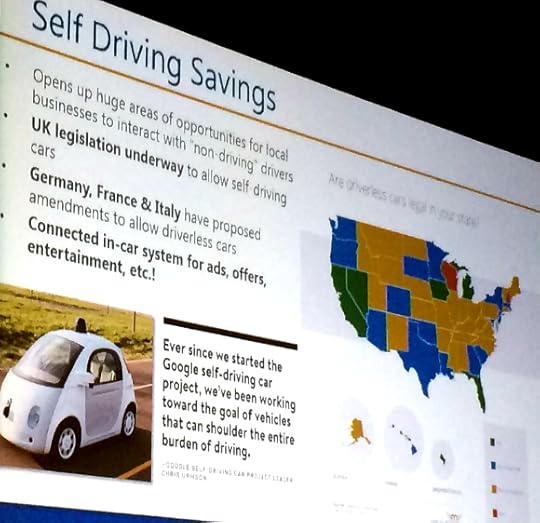
Forrester gives facts about driverless cars; map shows states where they are legal (above)
All Your Data is Out There
Forrester says, “Data is the new oil.” Why? It’s the most valuable commodity in the world and it’s growing exponentially.
Right now, you’re leaking data. Data signals are everywhere. You might be concerned about this … but what can you do? According to the Federal Trade Commissions, Axciom has a minimum of three thousand data points on every single person in the U.S.
Axciom has a minimum of 3,000 data points on every person in the US, per @DuaneForrester keynote.
Click To Tweet
Where Are We Going? Machine Learning
Forrester quotes billionaire magnate Vinod Khosla: “In the next 20 years, machine learning will have more impact than mobile has.”
Forrester agrees. Search systems now have the raw data to start making sense of the world in which they exist. Examples of machine learning at work:
Bing has been able to pick the Eurovision winner.
How-Old.net can look at you and determine your age and gender.
Google machine learning systems learned how to identify faces without explicitly being told how. [Tweet “Google machine learning systems learned how to identify faces w/o being told how – @DuaneForrester”}
We can know everything.
The Future of Search
A time of limitless expectation and technology. Search is advancing:
To be the bridge between a user’s intent and experiences the world has to offer.
To allow users to express themselves in natural, intuitive ways — not just punch keywords.
To become the ecosystem of connected devices that serve relevant information.
One way into all the riches? Use Schema.org.
Agents
Imagine an Agent working for you to:
Watch for concert tickets and buy them.
Scan for discounted airfares to selected destinations and book them.
Proactively search for coupons, sales and announcements.
Accept invitations on your behalf and update your calendar.
Organize your calendar — manage running errands against traffic and other events on your calendar.
Imagine telling your Agent, “I need a cable for my phone,” and not having to think about it again until the cord shows up at your hotel. That’s the reality that’s coming. Your Agent will know what phone you have and what cord you need, where you’re staying, and be able to search to find a retailer who can deliver that phone to your hotel.
Will you be ready for the day search is internal, not external? When search is baked into every touchpoint we have? When it’s no longer a destination page, but something that brings you answers without your asking for them?
When considering the future of search, remember:
Data is critical: sharing it, consuming it, understanding it.
Know what motivates the upcoming generation.
Traditional online marketing is changing now, today.
Stop thinking about driving traffic.
Start think about visitor task completion.
Solve for consumer needs three steps ahead to win.
If you think mobile is coming, you’re already losing.
Read “Future Crimes.” Forrester just read this book, written from a cyber-crime point of view. It dives deep into EULAs and explains coming problems.
Social Media in a Mobile World – Pubcon Liveblog
Social Media in a Mobile World – Pubcon Liveblog was originally published on BruceClay.com, home of expert search engine optimization tips.
 Two social media managers are sharing their strategy when it comes to social for mobile specifically, in this Pubcon Las Vegas session aptly titled “Social Media in a Mobile World.”
Two social media managers are sharing their strategy when it comes to social for mobile specifically, in this Pubcon Las Vegas session aptly titled “Social Media in a Mobile World.”
Tips for Surviving Social Media in a Mobile World
Cynthia Johnson (@CynthiaLive), director of marketing and social media at RankLab, has five tips for social media on mobile.
Tip 1: Know where to spend your time. You can’t be everywhere all time. Mobile web traffic surpasses desktop. 85% of the time spent on mobile is spent on apps. Mobile users tend to share twice as much as desktop users.
Top Apps
YouTube
FB Messenger
Google Search
Pandora
Tip 2: Understand the goal of mobile app: it’s that you never, never leave. Once you leave an app, chances are you won’t come back for 15 minutes.
Tip 3: Be aware of dark social media. Dark social is the direct traffic that you can’t track. According to RadiumOne, “dark social represents more sharing activity than Facebook and all other public sharing channels combined.” An example of direct traffic on social is when a user clicks a link from Instagram. The solution is URL building.
Tip 4: Make sure your content is mobile-friendly. If content isn’t structured to fit a mobile device, it won’t be seen properly. To learn more about your Facebook audience, use Nuvi.com. Use Twitter cards. You get more space when you create a Twitter card:
Tip 5: Before you optimize connect and inform. Link everything. When they leave your app or site, you ideally want them going to another one of your properties. Use markup on your website add your social profiles to the Google Knowledge Panel. Even if it doesn’t show up, this is important because it’s letting Google know who you are.
Super-Charged Social Media Analytics
Kendall Bird (@SimplyMeK), handles social media for Collegis. Social media, she says, is all about expression and connections. Photos, videos, tweets, likes, shares – we’re doing this as people and as brands. It’s more than this, though – you must know the ROI. Social media is not just fun and games.
Social media is a powerful weapon for a brand. All platforms have native diagnostics. How do you tell the story based on these numbers? Track the numbers through native dashboards and third-party app vendors like HootSuite Analytics.
Turning Diagnostics into KPIs
You must look at web traffic from social media. You must track with Google Analytics. Use the Social report found in Acquisition. Here, you can find network referrals, trackbacks, conversions, user flower and more, and you can segment these factors by specific social platforms.
Build a dashboard that highlights your KPIs. This is how you showcase economic value to stakeholders.
One of Bird’s clients had a piece of content was shared more than 2,200 times on Twitter. After a little digging, Bird discovered it was a professor from Texas who tagged three people in his original tweet, and then those people tweeted it out, and it spread like wildfire. These are the kinds of stories she uses analytics to find.
How do we work smarter rather than harder? Use tools, like:
HootSuite: analytics platform.
RiteTag: Google Chrome plugin that automatically populates hashtag info.
Keyhole: a hashtag helper.
TrueSocialMetrics: plugin in social networks and analyze historical data up.
Google Analytics: fall in love with it; this is where stories are told.
October 7, 2015
SEO in a Two Algorithm World: Pubcon Keynote by Rand Fishkin
SEO in a Two Algorithm World: Pubcon Keynote by Rand Fishkin was originally published on BruceClay.com, home of expert search engine optimization tips.
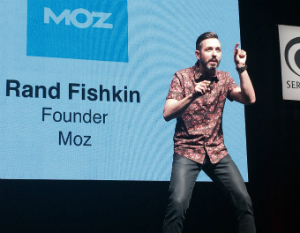 Rand dedicates this presentation to Dana Lookadoo, who will always be with us.
Rand dedicates this presentation to Dana Lookadoo, who will always be with us.
This author’s TL:DR take: On top of traditional SEO optimization factors (ranking inputs include keyword targeting, quality and uniqueness, crawl/bot friendly, snippet optimization, UX/multi-device optimization) SEOs need to optimize for searcher outputs (CTR, long-clicks, content gap fulfilment, amplification and loyalty, task completion success).
Here’s where you can get the presentation: http://bit.ly/twoalgo
Onsite SEO in 2015: An Elegant Weapon for a More Civilized Marketer from Rand Fishkin
Remember when we only had one job? We had to make perfectly optimized pages. The search quality team would get it ranked and they used links as a major signal. By 2007, link spam was ubiquitous. Every SEO is obsessed with tower defense games because we love to optimize. Even in 2012, it felt like Google was making liars out of the white hat SEO world (-Wil Reynolds). Rand says today that statement isn’t true anymore. Authentic, great content is rewarded by Google better than they ever have. They’ve erased old school practices like combatting link spam. And they’ve leveraged feat and uncertainty of penalization to keep sites inline. It’s often so dangerous with disavows that many of us are killing links that provide value to our sites because we’re so afraid of penalties.
Google has also become good at figuring out intent. They look at language and not just keywords.
They predict diverse results.
They’ve figured out when we want freshness.
They segment navigational from informational queries. They connect entities to topics and keywords. Brands have become a form of entities. Bill Slawski has noted that Google mentions brands in a number of their filed patents.
Google is much more in line with their public statements. They mostly have policy that matches the best way to do search marketing today.
During these advances, Google’s search quality team underwent a revolution. Early on, Google rejected machine learning in their organic ranking algorithm. Google said that machine learning didn’t let them own, control and understand the factors in the algorithm. But more recently, Amit Singhal’s comments suggest some of that has changed. In 2012 Google published a paper of how they use machine learning to predict ad click-through rate. Google engineers called in their SmartASS system (apparently that’s ACTUALLY the name of the system!). By 2013, Matt Cutts at Pubcon talked about how Google could be using machine learning (ML) publically in organic.
As ML takes over more of Google’s algo, the underpinnings of the ranking change. Google is public about how they use ML in image recognition and classification. They take factors they could use to classify images and then training data (things they tell the machine is a cat, dog, monkey, etc.) and there’s a learning process that gets them to a best-match algorithm. Then they can apply that pattern to live data all over.
Jeff Dean’s slides on Deep Learning is a must-read for SEOs. He says that this is essential reading and not too challenging to consume. Jeff Dean is a Google fellow and someone they like to make fun of a lot at Google. “The speed of light in a vacuum used to be about 35 miles per hour. Until Jeff Dean spent a weekend optimizing the physics.”
Bounce, clicks, dwell time – all these things are qualities that are in the machine learning process and the algo tries to emulate the good SERP experiences. We’re talking about an algorithm to build algorithms. Googlers don’t feed in ranking factors. The machine determines those themselves. The training data is good search results.
What does deep learning mean for SEO?
Googlers won’t know why something ranks or whether a variable is in the algo. Between the reader and Rand, does that sound like a lot of the things Googlers say now? 
Search and Social Content Strategy – #Pubcon Liveblog
Search and Social Content Strategy – #Pubcon Liveblog was originally published on BruceClay.com, home of expert search engine optimization tips.
How much time should you spend creating and promoting your online content? What’s the relationship between search and social? Get practical and effective content tips from the experts in this Pubcon Las Vegas session called Search and Social Content Strategy. Jordan Kasteler, our very own Mindy Weinstein, and Bill Hartzer all share their unique tactics on how to improve content that wins for both SEO and social campaigns.
Jordan Kasteler: Push Your Content to the Next Level
He’ll be covering these topics:
Creating vs. promoting content
Sharing success
Promotion don’ts and dos
Content measurement
CoSchedule says you should spend at least ¼ of the amount of time you spend creating the content to promote it. Jordan says that’s the minimum and you should spend equal amount of time creating as promoting.
He gives us a few examples to show that there is no correlation between shares and traffic. People share content without consuming it.
Promotion Don’ts: propel promotion of your content by:
Don’t spam. Use these tactics sparingly.
Don’t share if you don’t feel good about your content. If it isn’t good enough, make it better or don’t share it.
Link sharing sites (delicious, stumbleupon, reddit) let you submit content into democratic vote systems and it can propel content up to tens or hundreds of thousands of page views.
Niche link sharing sites: inbound.org, growthhackers, biz shugar, and Lawster.
Visual sharing sites: If you’re sharing visual content, Pinterest and Instagram (can be harder to drive traffic to your site due to the nature of it being a mobile app with no links in post captions).
Post to social groups: LinkedIn Groups, Google+ Communities, Facebook Groups – the real value of LinkedIn, Google+ and even Facebook is in the power of groups. It’s a niche community who are engaged, have their own blogs and may share and propel your content.
Indicate authorship: For example:
Niche forums – there are still niche forums that can drive traffic to your audience.
If it’s a credible forum, there are community rules.
Syndication sites: BuzzFeed, tumblr, Medium, LinkedIn Pulse. Copy and paste the content and at the end link to the “source.” If you do a private syndication site (like a very niche blog), make sure to indicate the canonical source of the content with rel=canonical.
Paid syndication sites: Outbrain, Taboola – these are the sources you see as “related content” or links in Huffington Post, for example. It’s especially good for clickbait like content.
Make it Easy to Share and Link: include social media share icons or embed code. Narrow down the options that you want people to use to share.
Link to Past Content
Get Employees to Share – encourage your employees to like, share and comment on posts on selected social media platforms. Turn your employees into brand ambassadors.
Email others: weekly or monthly emails of your top posts and reach out to influencers.
Sharing timing – test this out on your own. Time your scheduled Facebook posts, 5 to 10 minutes before the hour. People waiting on phone calls may be more inclined to click on your content.
As far as resharing, Twitter is where you have the most leeway for sharing multiple times. People often share once and don’t reshare.
As a rule of thumb, reshare until people stop engaging with the content.
Support sharers of your content. See how they shared your content. If you see people continuing to support you, support their content too. It’s a reciprocal feedback loop.
Support comments and reply to every comment.
Cross-promote between paid, owned and earned.
Use your email signature to show people where you write content.
Measuring the ROI
You have so many metrics. You see time spent, bounces, exits, on-page metrics, social metrics. How do you know which to look at to decide if content is successful? Look at the Moz “the one metric” post and you can pull in all these metrics and combine them with a weighted score. This provides an idea of how content is performing at a glance.
Mindy Weinstein: Search Social Content Strategy
How do you create the content – knowing the people who are going to read it and share it.
Three main takeaways:
Know your audience inside and out.
Understand the relationship between search and social.
Publish the right content for the right people.
Know your audience inside and out. Think about the evolution of the user, as search engines are following it. Focus on who you’re trying to connect with. Keyword research is one secret to understanding what words your audience is using. A tool for the job: SEOTools.com/ksp-tool.
Personas: identify characteristics of your target audience, including their goals and beliefs. What to read: “Web Personas: Creating Jane.”
Surveys can take out the mystery. Use SurveyMonkey.com to ask customers what matters to them and what questions they have.
Talk to your customers or people in your company who are on the front lines.
Look at the Share a Coke campaign. People’s names on Coke cans are highly shareable because everyone’s name is their favorite word.
Understand the relationship between social and search because your SEO job is to be the expert. Social expands your reach and visibility (so does search), but your focus should be on relationships and engagement. Lush Cosmetics is her example of a brand who does this right.
Hashtags – more low hanging fruit that you don’t want to forget to categorize your content and get it in front of people. Just because you take spaces out doesn’t make it a hashtag.
Publish the right content for the right people. Check out SocialMention for idea generation. She gives an example of the Domestic Violence Center. Their website and social media posts were focused on victims of domestic violence but those channels were really supposed to gain more donor support. Their first event since Mindy started working on their web content they got 3x the donations.
What’s the right frequency? There’s no one answer. Look at what are your competitors doing. What do your customers expect? Tool to try: perchapp.com.
Create headlines that attract search engines and readers – then create headlines for your social networks! Tool: the emotional marketing value headline analyzer. The tool scores and EMV (emotional marketing value) of a given headline.
Bill Hartzer: Search and Social Content Strategy
Bill’s been doing organic/natural SEO since 1996. He’ll give a history of social signals and how they impact rankings.
History of social signals and SEO:
Real-time search launched December 2009. Google started to show a Twitter firehose of tweets in search results. In July 2011, the Twitter firehose ended and then just this year it’s been reinstated.
Google’s goal in 2009 is the same as today – the freshest and most relevant content in search results.
Google has been vocal on social signals as a ranking factor:
Bill says that he expects in 2019, Google could be using social signals 100% of the time and maybe today it’s more like 50%.
What can you do now? Set up social profiles, post something on each social account, personal account, company accounts, actively every day. Promote Facebook posts, even just $5, because Facebook basically doesn’t show brand content without paid promotion.
Google+ – don’t remove authorship from your sites. It may come back at any point if google decides to use it again.
Optimize your profile on Google+ – fill out the entire fields and make it unique content. Share and create a visually rich experience.
He normally doesn’t post at 5 o’clock on a Friday before leaving the office for the weekend because the promotion piece needs time to pull together. Write several versions of the title/headline/summaries because you don’t want duplicate content.
Promoting posts on social media sites – network with others to help promote. Bloggers write the alternate post, summary post and links to you. Promote both summary posts and main post.
We know that +1s, tweets, and likes don’t count as social ranking signals. But we should keep sharing because traffic goes up with social visibility.
Content Promotion Strategy for Marketers, Including Pay to Play – #Pubcon Liveblog
Content Promotion Strategy for Marketers, Including Pay to Play – #Pubcon Liveblog was originally published on BruceClay.com, home of expert search engine optimization tips.
Influencer marketing and social ads are the hot topics up for discussion in the “Content Promotion Strategy: Including Pay-to-Play” at Pubcon Las Vegas. Speakers Will Scott, Phillip Thune and Casie Gillette are going to walk through their best strategies.
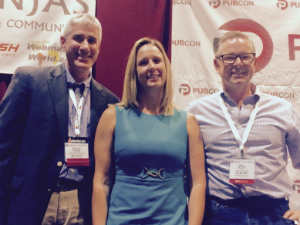
Phillip Thune, Casie Gillette and Will Scott
Native Advertising – Will Scott
Will Scott (@W2Scott), CEO of Search Influence, has four main points:
True social is getting a lot harder.
Traditional media is selling out.
Platforms are continuing to emerge and will for another five years.
Great content still really matters.
Social media really gets value from good content — it’s about human response, rather than rankings on Google. The content that one creates for social is typically way better than the content created with only SEO in mind, he says.
His tip for getting your content shared socially? Make it native advertising or sponsored content.
“Advertising used to be more obvious. Ads were clearly ads. Sponsored content? Not so much,” says Scott.
Advertising used to be clearly ads. Sponsored content? Not so much. – says @W2Scott
Click To Tweet
Are native ads just better monetized PR?
Newspapers have been brand-building for the last hundred years. Leverage their brand for your brand.
You can buy placement for your articles on:
Tabula
Outbrain
Yahoo Gemini
Remember, this is not about SEO — it’s about marketing, he says.
Nativo and Polar get your sponsored content into news feeds on online newspapers and make the native content look like the newspaper sites it’s populating on.
Influencer Marketing – Phillip Thune
Phillip Thune (@textbroker), CEO of Textbroker International, is going to talk about influencer marketers. But first, he lays out the benefits of influencer marketing.
Benefits of Influencer Marketing
Brand awareness rises.
Credibility enhances and consumer trust builds.
Search engine rankings improve.
Reach expands.
Inbound leads are generated (No. 1 benefit in Thune’s opinion).
How to Approach Influencer Marketing
Identifying relevant topics is the first step in influencer marketing. What is your audience interested in? Research what type of content is popular with your competitors. Measure user behavior with Google Analytics. You can also simply use the search command “related:www.yourbusiness.com” to find out who Google sees as your competitors.
Tip: Search ‘related:www.yourbiz.com’ to find out who Google sees as your competitors. –…
Click To Tweet
Choose the right influencers. Find them with this criteria:
Reach: To reach the largest audience possible, the person must have followers.
Context: For a large following to serve its purpose, the audience has to be interested in and relevant to your industry.
Credibility: To convince followers to complete an action or follow through with a recommendation, the influencer must be considered a credible source.
Find influencers on platforms like:
Traackr
BuzzSumo
Cision
Convince influencers to help you. You have to compensate them with:
Money or free products and services
Cross-promotion
Engagement
Influencer Marketing in Practice
ModCloth: Their target audience is women interested in vintage fashion. They embarked on influencer marketing by promoting women wearing ModCloth clothes on their site (providing the women engagement and visibility), which in turn led those women to share those promotions on their social networks.
Kraft: The food retailer used TapInfluence to find influencers and then paid influential bloggers to post recipes using Kraft products. They received 16,000 clicks to coupons and 760,000 views to the 180 recipes that were created.
Content: Creation, Planning and Promotion – Casie Gillette
Casie Gillette (@CasieG), director of online marketing at KoMarketing, starts out by noting we’ve all been taught that content is king. But she says enough is enough. The goal isn’t to create as much content as you possibly can, but to create good content that your audience wants. You’re spending time and money on content, so it shouldn’t be a waste.
Every piece of content has three components:
Creation
Planning
Promotion
Just putting something on Facebook or Twitter doesn’t mean you’re going to get reach. How do you cut through the noise?
Creation
You have to have content that your audience likes. Look at your landing page reports and find out what your top content and top converting content is — then create more pieces like that. This boils down to money — you need to create content that drives sales.
Gillette recommends BuzzSumo to look for more data on your content, as well as your competitors’. Where is the content being shared? Who is it being shared by? Find out.
Planning
Look at your referral traffic in Google Analytics. When you create more content like the content these have shared, reach out to those referrers — you already have an in!
Build a list of influencers and use that list in social ad targeting. She recommends Followerwonk for building the list, as well as BuzzStream.
Promotion
It sucks, but we have to pay now. But if you’re going to pay, make sure you’re paying to reach the right people.
It sucks to pay to promote content. But if you pay, make sure you’re reaching the right people….
Click To Tweet
If people are posting questions in Quora or other forums and your content speaks to those questions, share it with them. It’s not spam when it’s useful.
Don’t make up hashtags. Use Keyhole.co to find out what hashtags people are actually using. It will show you who’s using those hashtags, as well as other useful data.
The whole point is that when you launch a piece of content, you know who it’s going to and you have a plan in place. This is it — the promotion is executing everything you planned.
Google AdSense AMA Keynote: Ad Blockers, Accelerated Mobile Pages and EU Cookies
Google AdSense AMA Keynote: Ad Blockers, Accelerated Mobile Pages and EU Cookies was originally published on BruceClay.com, home of expert search engine optimization tips.
Good morning from Las Vegas! Brett Tabke, Pubcon’s founder and this morning’s moderator, says this is only the second time that AdSense has been chosen as a Pubcon keynote topic. This is an Ask Me Anything-style format, and these questions came up from different forums and places, including WebmasterWorld forum. The topics in this quick Q&A range from how Google is trying to solve the problem with ad blockers to the just announced Accelerated Mobile Pages project and EU cookie issues.
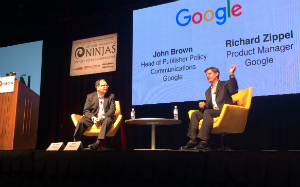 Our distinguished Googlers introduce themselves.
Our distinguished Googlers introduce themselves.
Richard Zippel, Product Manager, Google — Richard is a new Googler (about 4 years) and he’s a product manager for publisher quality. No one knew what that role was at the time he took the job.
The best way to think about publisher quality is to think of the people involved in the ad ecosystem — 3 distinct parties — users, advertisers, publishers. We need to make sure the interests of each of those 3 parties are equally balanced. If any of the 3 are out of balance, it will tip like a tripod. If users get frustrated, then they’ll go other places and then there will be fewer places for Google and publishers to monetize.
Google wants to encourage publishers to do the right thing and make it easy for them to do the right thing, for the betterment of users’ experience. The way Google does this is through policy. Here’s an example of a time that a policy wasn’t quite right the first time. The number of ads on a page is a policy — the AdSense policy is no more than 3 ads on a page. Seems like a reasonable policy. And then people started reading long articles, and a reader can read down a page for 5 minutes and it makes sense that there could be ads further down the page. To get around this, publishers started chopping up articles into galleries and multi-page articles, and that contributed to a bad user experience. This was a well-intentioned policy, but it didn’t work. He looks for ways to develop future-proof policies.
John Brown, Head of Publisher Policy Communications, Google — John’s also a Noogler (new Googler) and works with publishers and internal stakeholders to create materials to use to stay compliant and take advantage of best practices. Less than a year ago he was in leadership roles at digital advertising. In 15 years in the industry, he came to know how policy can help grow businesses.
He sees the importance of balance between users, advertisers and publishers. He’s dedicated to enabling a healthy market for all three groups. When he was in a role similar to ours, he wasn’t excited about policy issues but rather was into doing deals and optimizing — so he understands the pain points of this audience. Google tries to develop policies that are transparent and simple, and knows that they can do better. Google wants feedback, welcomes questions and dialogue. They are actively open to making changes.
Question & Answer on Google Publisher Policy
Ad blockers — what can publishers do to address this hindrance? What is Google doing?
Richard: Ad blockers are a systemic problem. Ad blockers are a symptom that at least some of us have taken our eye off the ball — keeping users happy. Google is very concerned about it. There are lots of things that contribute to the desire of people to have ad blockers. One of these prominent reasons is that lots of ads on a page make pages load slower, especially on mobile. Accelerated Mobile Pages is a way to organize a website so it loads faster than before — and that’s a solution Google announced today.
John: There are lots of resources looking at the various things we can do.
The EU cookie law — when do webmasters need to put this on their site? American publishers are concerned about it.
Richard: It’s very simple. Generally you need it. The problem is the way the law is written, on websites used by users in Europe, there needs to be the disclaimer/announcement about cookies. Google has looked at the law carefully; they’re not challenging it. Everyone has to abide by it.
There’s a complication with law and the Internet. Countries have boundaries and the Internet crosses all of those. Every entity tries to establish laws to protect its own citizens. How it all balances out is a problem. It’s a bigger problem than the cookie issues. The Right to Be Forgotten is another example. This is a hard one. Our position is that if your site is viewed by people in Europe, this is what the law is. That’s our assessment of the state of the law.
If you don’t put up the EU notice, that doesn’t put you in violation of AdSense policy.
Will Google Shopping/product feeds be put into the AdSense feed?
Richard: I can’t talk about any future plans, and I’m not aware of any plans for this.
Any newer policies as a result of mobile?
Richard: We’re looking to better understand the rationales for the policies we have. Getting our own internal people as well as publishers to understand what they are is critical to preserving the ecosystem. Three ads per page is the simple example. There’s a general feeling that things have tipped away from the user.
In the Verge, I recently read an article that the introduction of ad blockers into iOS9 was a knife to the heart of the Google revenue stream.
Richard: I can’t speculate on Apple’s or Facebook’s business strategies.
Any new announcements to make?
Richard: Say we do. Don’t steal our thunder.
What can a publisher do to increase their revenue?
Richard: If I knew the answer to that then I wouldn’t be sitting here, I’d be off creating the world’s greatest website. Google has lots of products. Not everyone’s content is appropriate for all products. We have products for videos, AdX, choosing the right mix of those products is a good idea. If you’re not in mobile, then you should be. Figure out the best way to do that with the changes to iOS, to Android, and to wearables. The final thing, which is probably the first thing, is make your users happy.
Amazon claims that on its website, a 100-millisecond load time improvement is worth $100M a day.
Richard: The faster your website is, the happier the users will be. The accelerated mobile page project is one example of what we’re doing in that area. If you had one ad on the page I bet you wouldn’t have an issue with load time. So what’s the balance of the ads, the video, use the technology in the best way for the user.
Referral spam, this time last year was a minor annoyance. Now we’re seeing ghost referral spam, never hitting your server, hacked your code to falsely inject your server with false referrer data.
Brett: This is an analytics problem, a ton of referral spam happening these days.
This takes us to the end of our time. My takeaway: Whatever problem you face as a publisher running ads, Google thinks that problem will be solved when publishers make user experience their primary concern.
Keywords and Keyword Research – #Pubcon Liveblog
Keywords and Keyword Research – #Pubcon Liveblog was originally published on BruceClay.com, home of expert search engine optimization tips.
Keyword research – it’s the first step in the search engine optimization process, according to Bruce Clay, Inc. In this Pubcon Las Vegas session, Bruce Clay himself along with fellow presenters Craig Paddock (@craigpaddock) and Ash Nallawalla (@ashnallawalla) talk about how to perform the best possible research methods for your keyword processes.
Craig Paddock: Content and Topic Research
Hummingbird is making it so we’re not targeting keywords but topics and multiple synonyms, says Craig Paddock.
70% of queries now involve synonyms and 98% of the time Google properly serves results for synonyms.
The SERPs for “boxing equipment” and “boxing gear” are the same.
We’re losing keyword data from analytics at a rapid rate. There are some workarounds for Not Provided. His agency provides an organic report by URl in GA. We get some partial data from bing/yahoo/google. You can get some data from Search Console. You may want to implement site search if just for the data intelligence. You get data from paid search and AdWords. Here are some keyword data sources:
Search Console Queries: no performance data (goals, $$$), limited to 90 days
Search Console data in GA – again no performance data, limited to 90 days
AdWords Organic report – connected to Search Console account, AdWords account under Dimensions tab, no performance data or landing page, no historical data. It’s great because it shows organic CTR with paid impact
Keyphrase (content) research selection factors:
Popularity
CTR
Quality
Competitiveness
Engagement
Be an authority:
Don’t just target top sales terms
Be an authority and be interesting
Keyphrase ideas:
Best – target with anchor text
“Wholesale” in the retail businesses is not as competitive and has 50+% CTR
Glossary
“Nearby” queries are up 100% YOY
How to queries are up on YouTube 70%
“Your company reviews/complaints” – provide a direct option for complaining before they post to Yelp of consumer affairs
Most important keyword phrases:
Primary site
Paid search listing
YouTube channel/Vimeo
Facebook/Twitter/Google+
Wiki
Flickr/Pinterest/Instagram/Tumblr/Slideshare
Microsite
iTunes app page/Google Play
Amazon
As a case study (we were not prepared for this and Bruce, on the stage, does a double take!) if you search for “Bruce Clay,” you see he controls the content on the first TWO PAGES.
Industry tools:
Google Keyword Planner
Google Trends (new and improved July 2015)
[I couldn’t type fast enough to get them all]
Paid search campaign data
Heads up: GA Matched Search Query is very broad and getting broader. Travel keywords are matching for “time travel,” for example.
The paid impact on organic: Google says paid ads don’t impact organic rankings. However, a $200M paid search campaign later, he found that people link to pages and share pages more as an indirect result of a paid search campaign.
When looking at your rankings, be sure to look at the non-personalized results.
You may also look to take advantage of result clustering, where Google takes a website’s results at multiple positions and groups them in the listings all together so it’s like you have more results ranking higher.
CTR by position segmented by query type (branded, ads by the brand on the page, etc.):
In summary:
Ash Nallawalla: Lateral Keywords for Writers
Ash looks after 8 brands in the Suncorp insurance and banks company based in Melbourne, Australia. He’s speaking to the writers and SEOs working with writers, sharing discoveries and an Excel file (published by Eric Enge) and how he modified it to become something else.
Keywords: everyone’s using the Google Keyword Planner to get a feel for the most searched terms. You probably use it and your competitors do too. We use it as a starting point. Search intent is important. Intent can be navigational, info, commercial, transactional. This is the background, to set the scene.
So, who is winning in your niche? Check out the competition. See the content they sue on their sites. He has a 1-hour presentation (link: http://trainsem.com/pubcon) to show us how to make a ranking spreadsheet. “Visibility” is important, but what is your wat to measure it? Which competitor is more visible? Choose your top 5 competitors.
The content writer’s dilemma:
The spreadsheet shows the winners, not the losers. We can see who is using the most searched phrases. What content are they using that you are not using? Ranking involves many other factors. And this is also about selling!
Looking for that lightbulb moment? It’s time to think about keyphrase frequency. See Eric Enge’s TF-IFD Moz article.
Term Frequency: how frequently the term appears in a document (including stop words). There’s a fancy formula on the screen which you can presumably get from Eric Enge’s article. No need to fear the formula. Once you plug it into Excel you never have to look at it again but can get all the benefit of its analysis.
Look to sell, not to rank. If it helps you rank, great, but don’t have that as your goal.
Get n-grams (one-word, two-word and three-word phrases) from a keyword density tool analysis of your five competitors. Those are the key phrases to include in your worksheet. Get a count of each word or phrase used by the top five pages and your page(s). Then, do the TF number crunching. Use conditional formatting to pick a range of TF values and compare your TF column with the average TF of the competitors. You will now see significant words to consider. When doing this you’ll find that the pages you’re analyzing may not contain some obvious words. This is the beauty of this technique.
Bruce Clay: How We Look at Keyword Research
Bruce agrees that Ash’s description of keyword research is right on how to do it. The SEOToolSet Multi-Page Analyzer does the analysis of what Ash describes minus the statistical analysis. But it does ID competitors and their most-used words.
Talking about subject matter experts and speech recognition and basics of research @bruceclayinc
A photo posted by Bill Slawski (@billslawski) on Oct 6, 2015 at 3:13pm PDT
Use the right keyword when building your site. All keywords should be based on search volume, how people are searching and what people are doing to find you. Understand what you’re trying to get across to your audience, and know that there are different keywords based on regions, and much more. Also, pay attention to keywords based on media (including voice).
Keywords and keyword research: the steps
Generate a seed list (basic 101)
The client keyword list
The site
Search Console Traffic > Search Queries
Google Analytics
Find more keywords – Related searches at the bottom of every SERP
Find more keywords – Google Instant
Understanding keywords (or, using wisdom to evaluate and select keywords)
There is a difference between data and wisdom
Having a keyword list is not enough
Most lists are excessively broad
Each keyword is a new SEO project
Most sites cannot produce expert content for too many keywords
What worked in the past is past
Panda-related quality penalties come down to trying to be too broad and thus not an expert. Choose wisely. Narrow your focus. Know your market. Do this by considering:
Google audience and personas
Transactional or navigational (commercial or informational)
Millennial + gender and region
Voice, mobile and desktop
Expertise focus
Focus on a specific, high-level expertise. Be the subject matter expert for any keyword you’re trying to rank for. How close can you get to being recognized as the expert? A poor selection of poorly matched keywords and mediocre content on too many topics is going to hurt rankings. Two years from now, the only viable keyword is the one you’re an expert on.
Major AdWords Mistakes and How to Prevent Them – #Pubcon Liveblog
Major AdWords Mistakes and How to Prevent Them – #Pubcon Liveblog was originally published on BruceClay.com, home of expert search engine optimization tips.
Our own David Szetela takes the stage along with Mona Elesseily to share insights on mistakes that search engine advertisers commonly make. This Pubcon Las Vegas session targeting the paid search crowd is titled “The Top Major AdWords Mistakes and How to Prevent Them.” Take in these veteran PPC pros’ advice and you may avoid the PPC mistakes that even the most savvy search marketers sometimes make!
 11 Top Major AdWords Mistakes – David Szetela
11 Top Major AdWords Mistakes – David SzetelaBruce Clay, Inc.’s vice president of search marketing operations, David Szetela (@Szetela), has narrowed down the top 11 mistakes he sees being made too often on AdWords.
1. Don’t Trust the Search Query Tool
The search query tool is a great tool, but don’t trust it blindly. The tool frequently adds negative keywords at the campaign level, but it’s better to use a broad match, single-word variation of the exact match keyword the tool automatically chooses.

David Szetela demonstrates negative search term research (click to enlarge)
It’s almost always better to add Exact or Modified Broad match versions of the selected keyword.
Tip:
Pull account into AdWords Editor.
Get Recent Changes.
Back in the AdWords web user interface, add keywords as Broad.
Back in AdWords editor, get recent changes again. The added keywords will appear highlighted green. Change the match type to Exact.
2. Google Display Network (GDN) Negative
Often seen when search ad groups are simply copied into Display campaigns. This is truly a rookie mistake.
Negative keywords tell AdWords, “Don’t show my ad on any pages that contain any of these words.” This causes very limited reach, since many relevant pages contain those words.”
The easiest fix is to just delete negative Display keywords.
3. Ads on Mobile Apps and Games
Google loves to do this. Your ad probably isn’t going to convert on a children’s game. Exclude placement with adsenseformobileapps.com.
4. Too Many Ads
For an ad test, more than two ads per ad group is usually too many. This takes too long for data to accumulate such that clear winners and losers emerge. You can test three ads only if your ad group accumulates many conversions quickly.
5. Obsessing Over Quality Score
Obsess over CTR, and a high Quality Score will come. Landing page quality is a very minor factor. You’ll only be penalized if load time is poor or content is sparse. Only worry if your Quality Score is 5 or below. Don’t worry if B2B CTR and Quality Score are low. Often, ad functions to screen out people outside your target audience.
6. Too Many Display Keywords
The ideal number of display keywords is four to six. That’s all the algorithm needs to characterize the theme of sites and pages where ads should appear. Having too many causes the algorithm to spread ads more widely and results in irrelevant clicks. Use the Display Planner tool.
7. Capitalizing Callout Extensions
Up to four callout extensions can appear in an ad. Google’s help pages say not to capitalize all the words in the call extension. Use sentence case. Trust Google. You’ll get a better CTR.
8. Tracking Too Many Conversion Actions
Let’s say you’re tracking purchases, email signups and whitepaper downloads. The issue is that each action has a different value, so the rolled up view of conversions gives a distorted picture of true return on ad spend (ROAS). Track one of two main (macro) conversions with AdWords and others with Google Analytics.
9. Blindly Opting Out of Search Partners
Many advertisers assume Search Partner traffic is inherently low in quality. The reality is that sometimes Search Partners CTRs and/or CVRs/CPAs are superior to Google Search. Test and report using Segment before excluding Search Partners.
10. Using High Commitment CTAs in Display Advertising
Search advertising is direct respond demand fulfillment, so high commitment CTAs like “Buy Now” are OK.
Display advertising is demand generation. The ad viewer isn’t ready/willing to take such a high commitment step. Buy, register, signup, etc., are too much commitment, while free download, free whitepaper, learn more and so forth are low-commitment calls to action.
11. Using Only “Old” Display Targeting Features
Old feature target sites: keyword and topic targeting. These are OK when a broad reach is desired, but otherwise they’re inefficient because many ads are shown on the wrong pages. Fixing this requires diligent, time-consuming exclusion of bad placements.
Szetela highlights the newer Display Targeting features: in-market, affinity audiences, and custom affinity audiences. He likes all of them. These target people based on their interests and activities, not sites. Google knows a lot about people, so it infers interests very well.
Szetela’s favorite among the new display targeting features? Custom Affinity Audiences, which are defined by describing interests and the kinds of sites frequented. Put a minimum of five keywords and five sites. So if you’re selling industrial power products, for example, you’re targeting managers of construction yards, as an example.
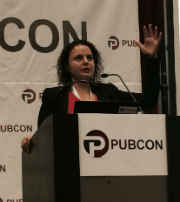 Avoiding Mistakes in the Paid Search Landscape – Mona Elesseily
Avoiding Mistakes in the Paid Search Landscape – Mona ElesseilyMona Elesseily (@WebMona) is the vice president of Online Marketing Strategy at Page Zero Media. She opens by talking about the landscape of search right now. She points out the two biggest trends currently:
We’re losing desktop share to mobile devices.
Search is more fragmented as people search on different devices.
She also says there is more white space between ads on today’s SERP. Elesseily shows example of a SERP with one organic listing, with the rest of the page taken up with ads and a direct answer.
“Eventually all our SEO friends will be paid search people,” she (maybe?) jokes.
One of the biggest mistakes she sees is advertisers not using all available advertising formats. Google AdWords today is not what it was five years ago. There’s a lot more to AdWords than you might think. Consider using non-keyword advertising:
Dynamic Search Ads
Call Only campaigns
Google Shopping campaigns
Keyword Advertising Mistakes
Elesseily says 20 percent of your terms shouldn’t determine 80 percent of your traffic — branch out. Try product-related terms, brand-related terms, solution-oriented terms, etc.
Watch negatives. Include the following with your negative terms:
Singular
Plural
Misspelling
Stemming (tenses)
Abbreviations
Mobile Concerns
It’s some of the lowest converting traffic around. Attribution breaks when people switch devices, so you have to consider the data incomplete. Fast facts:
40 percent of ad spend is from mobile.
Mobile searches are popular before and after work.
CPA decreases throughout the day.
Ad Copy Mistakes
Avoid wordy copy that says nothing. Don’t be cute. Don’t use adverbs. Keep it straight to the point. Think “bang, bang, bang.” Use one USP, one call to action and one unique value proposition.
Try different offers (e.g., fast shipping, large selection) and limited time offers.
Focus on special situations like 24/7 support or an official website.
Mobile Ad Copy
Make sure you’re using mobile preferred ads.
Use mobile-specific ad copy.
Make sure it’s readable.
Make sure it’s tap-friendly.
Keep load times fast (Google’s preferred load time is under one second!).
Use mobile-specific extensions (sitelinks, call extensions, location extension).
Elesseily‘s Favorite Tools
SEMRush
com
com
com
com
October 6, 2015
Building Great Content for a Brand – #Pubcon Liveblog
Building Great Content for a Brand – #Pubcon Liveblog was originally published on BruceClay.com, home of expert search engine optimization tips.
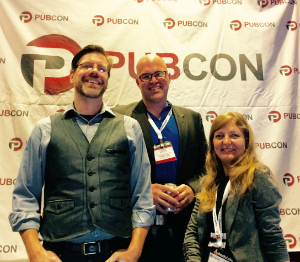
Stoney deGeyter, Loren Baker and Ann Smarty
Content – it’s a chief component in everyone’s digital marketing strategy. More than just tips, this morning’s Pubcon Las Vegas session on “Building Great Content” includes a case study on American Eagle Outfitters that highlights just how critical strategic content marketing really is. Read on for in-depth coverage of this session, featuring Loren Baker, Ann Smarty and Stoney deGeyter.
Content Marketing Piece Goes Viral – Loren Baker
Loren Baker (@LorenBaker), VP of business development at Foundation Digital and founder of Search Engine Journal, is going to share an example of intentional content marketing, as demonstrated with his client American Eagle Outfitters. But first, some of Baker’s general thoughts:
Content serves many masters:
SEO targets
Outreach targets
Social sharing
Social influencers
Ad enhancement
Content lifespan
Tools Baker likes:
Google Autocomplete
SEMRush
Majestic
SharedCount
American Eagle Outfitters Case Study
One of the things American Eagle Outfitters’ target demographic (millennials) is interested in is making products they buy their own — such as distressing denim for a unique look. This brand’s customers were taking new jeans, customizing them, and then putting them online.
Accordingly, Baker wanted to create a content piece all around distressing denim, perform outreach to influencers, and share it everywhere. The client, surprised, said wait — no one ever shares content from our blog. Baker then brought everyone to the table and looked at Google AutoComplete.

Google AutoComplete keyword research (click to enlarge)
The first thing they saw was that people were looking how to distress denim. There was a Direct Answer and videos in the SERP — and not one retailer.

Long-tail queries research (click to enlarge)
Using SEMRush, they looked at the volume of the long-tail keywords they were targeting re: distressed denim and developed a strategy.
They moved forward and created this content plan:
An in-depth blog post on distressing denim that was much more in-depth than the competition
An infographic visualizing how-tos and DIY tips with subtle product placement (be careful, though, because the more branded it gets, the harder it is to get the media to pick it up)
Content for social distribution on the client’s social channels
Material for the client’s customer email list
The results?
10,000+ Facebook likes
450+ Facebook shares
2,500+ other signals from social sites
25+ unique links (high Trust Flow)
500+ co-citation links
25,000 referrals per month from organic search
Baker reminds the audience that it’s important to hire quality writers and designers for things like this.
“Invest in passionate writers and designers. People can tell the difference between forced content and passionate content — the good writer might cost a little more, but it’s worth it. Also, you don’t have the back and forth, the revisions, etc. This applies to designers, as well,” said Baker.
Extra tip: Use the Bulk Upload tool on SharedCount to import all the sites that have linked to your piece of content and then see all the social activity across the web.
How to Mine your Own Mind for Content Ideas – Stoney deGeyter
Stoney deGeyter (@StoneyD), president of Pole Position Marketing, opens by saying, “I don’t know if this is something new and awesome, or born out of my own laziness — but I find that sometimes I’m my own best resource.”
You are your best cure for writer’s block. Advice from deGeyter? Look to your old content, of any kind, and re-spin it to make your old content newer, more exciting and better than the first time around.
Ideas:
Take an original writing as the jump-off point and rework it start to finish.
Turn a comment into a full post. Use your comment as a base for fleshing out a complete blog post on the topic.
Turn 140 characters into 600 words. (How do people write so many books? They take a nugget of information and then expand it out. This can be done with anything.)
Look to your posts and presentations.
Turn one post into many posts for new audiences. Break the original into single focus posts and try to reach different readers with each individual post.
Make an email response a blog post. Maybe you just provided some valuable information to a client — take that and rework it!
Speaking of clients — all that client work? Turn it into case studies for your blog. (But, of course, always mask the client.)
It works the other way around, too:
Turn a fact-filled blog post into an infographic.
Turn a series of blog posts into an ebook.
By changing content from one format to another, you’re likely to reach an entirely different audience for your brand. Look for opportunities to do this and you’ll win! Find more content ideation tips from deGeyter here: Ppmkg.com/75contentideas
Turning a Video Series into All Kinds of Content – Ann Smarty
Ann Smarty (@SEOSmarty), brand and community manager at Internet Marketing Ninjas and founder of MyBlogU.com, will talk about how her company used a video series for engagement.
“Everything has been written. Everything is a copy of a copy. It’s very hard to stand out, and it’s a very hard time for marketers to reach out to all the social media channels that we have. We’re trying to cover everything. How do you make your content marketing meaningful?” she says.
Her solution? Content repackaging.
“Add new value. Organize it in a different way,” she says, echoing deGeyter’s sentiments.
She talks about a video series that Internet Marketing Ninjas created. The content the videos make possible goes beyond just YouTube. Here are her ideas:
Put video bloopers and small clips on Instagram, Twitter, Fine.
Use funny animated GIFs (from the videos) in your promotions using GifDeck.in or Gif.com.
Turn the videos into podcasts for Soundcloud and iTunes.
Once the series has accumulated, they will make a course on Udemy.
Turn the videos into articles.
Bottom line? Don’t shy away from videos. You can turn how-tos into videos (using screenshots). Turn team photos into slide shows. Smarty recommends Animoto.com to accomplish these tasks.
Smarty’s Preferred Image Creation Tools
HaikuDeck
Canva
Draw.io
Create.ly
Piktochart.com
Venngage
Smarty’s final thought for brands and content marketers:
“Any time you think about content marketing, always ask yourself, what else can I do with this content? Every time! Don’t forget to think about that and make sure you don’t miss any opportunities.”
Long Term Success with Reddit – #Pubcon Liveblog
Long Term Success with Reddit – #Pubcon Liveblog was originally published on BruceClay.com, home of expert search engine optimization tips.
How much do you know about reddit, and are you using it the right way to build your online presence? Brent Csutoras, social media strategist and content marketer, takes center stage at Pubcon Las Vegas to help you not only understand reddit but also learn how to achieve long term success on the site.
Moderator: Stoney deGeyter, President, Pole Position Marketing (@StoneyD)
Speaker: Brent Csutoras, Social Media Strategist, Kairay Media (@brentcsutoras)
Reddit: The Catalyst for What’s Popular Online
Reddit is one of the aggregate sites that still consistently grows. Digg grew, crash, died. You can count the social aggregate sites that tried and failed. Reddit never makes an effort to grow or sell you on their site. They’re a massive community built of influencers – people likely to make a topic viral.
While it’s a huge community, it’s very misunderstood by businesses. There’s 100M US visitors that are educated, influential, spenders.
Understanding Reddit
Reddit is a platform. It’s a software solution. It’s not one community. Anyone can create their own community and can make their own rules. There’s no standard from one to the other. Think of it like WordPress or Tumblr. You start as a user but if you create a subreddit you will be a moderator and moderators can be assigned by other moderators. Admins actually work for reddit. They don’t get involved in subreddits unless you’re violating an overall site rule.
Front page of reddit is an aggregate of the subreddits that you’ve subscribed to. If you’re not logged in then the front page is the 40 most popular subreddits. The algorithm is a logarithmic voting algorithm. The first 10 votes that happen on a post are equal to the next 100, and those are equal to the next 1000.
Be anonymous. That’s how it’s done on reddit. If everyone’s anonymous on reddit then you should be too.
Become a redditor. Social is the place you should be marketing. Create content specifically for reddit. Understand X-post, FTFY, TL:DR. If you’re in the space, you care about learning, and you’ll actually get into reddit because there’s no better place to find out more about how things are progressing in marketing. It’s more than a community, it’s generally a great tool.
Comment before submitting. There’s no rule for how long you should wait to submit before you comment. Commenting is where the importance is on reddit. Comment on upcoming stories. Look at posts that are rising and find ones with only 1 or 2 comments where you can add some thought.
Find your passion in subreddits. Check those areas every day because then you can have something to say quickly and authoritatively. This helps you become a better reddit and helps your profile, success and understanding.
Submitting on Reddit
Understand the difference between a large community and an active community. Total count of subscribed users is not as valuable as how many users are here now. Check Redditmetrics.com. ID subreddits that are targeted and have high activity levels.
Read the rules every time you submit because they change and they don’t care if you don’t know and they’ll ban you and you may be silent banned and not even know it. Read the rules so you can tell if they preclude you from doing your ultimate goal, submitting links, for instance. Why waste your time somewhere if you can’t do what you want to do?
Make friends with moderators. Review the moderators and identify their interests. Look at redditinvestigator.com to research moderators and then submit what they submit. Find content that matches the content that they submit. It’ll come up to their attention that you are in line with their interests. This is a great way to get past an initial moderation requirement so your submissions are automatically approved.
Research. Domain search (site:) for what is already working. In the subreddit, research the top and controversial posts. Submit at the right time – 10 am EST or when right mods are active. After 24 hours the reddit algorithm strongly devalues the content.
Don’t spam reddit. It doesn’t work. It’s not worth your time. What does spam mean?
Reddit.com/r/spam – list of suspected spammer accounts. Spend a couple hours there and you’ll see the patterns redditors use as spam. You can also set an alert to see if your name is mentioned there.
Reddit focused content – recreate popular concepts over 6 months old. You can do a remix/spin of popular content. Or you can resubmit the same content because sometimes there’s a video that you may have seen a few times but it’s cute and you like to watch it again.
Reddit Gold – you, influencers, mods, you may want to be a Gold Partner. It’s a few dollars a month that can give your belonging an edge.
Reddit Ads – look at his presentations online.
AMAs are one of the most popular things on reddit. It’s an interview format and AMA is one of the most popular subreddits. One of the most popular is a vacuum repair guy and his AMA brought vacuum websites down with the traffic that he sent when curious people went to look.
Responding to comments: related threads, reddit exclusive offers, link to resources.
Things to remember:
Reddit is filled with influencers. It’s a great demographic audience and growing regularly.
Become a redditor and comment often
Find active subreddit with accommodating rules
Research what works
Marry the mods
Consider alternate avenues of marketing other than submissions












